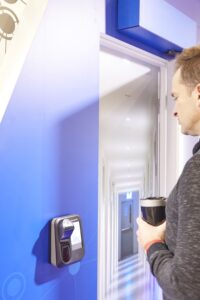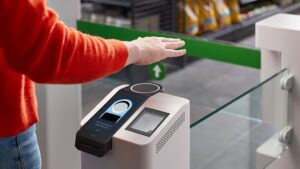4.26.23 – SSI –Bobby Varma & Lee Odess

Some simple changes to how biometrics are marketed to security stakeholders can open the floodgates to lucrative sales opportunities.
Like any new technology, security tech takes time to enter the mainstream. Early iterations are usually inelegant and pricy. Products require finessing. Stakeholders must feel it solves a real problem better than the established alternatives. Plus, the sales channel must be motivated to sell it.
During the past two decades, many new technologies have gained wide acceptance within the security market by meeting these three criteria. The growth of analytics and automation, Cloud-based video and access systems, mobile credentials and smart home devices are leading examples. They have become increasingly reliable and affordable, customers are demanding them, and security integrators are eagerly adding them to their portfolios.
Biometric identity solutions, however, have needed more help breaking into the commercial physical security space. Why should that be? The public welcomes the convenience such solutions offer. For proof, look no further than cellphone use: 80% of smartphones have biometrics enabled. People overwhelmingly prefer to use their face or fingerprint than enter a passcode each time they unlock their phone or interact with an app. The ease of biometrics is unmatched.
There are countless physical security applications in which biometrics could enhance the user experience, and yet very few integrators are offering such solutions. Some simple changes to how biometrics are marketed to security stakeholders can open the floodgates to lucrative sales opportunities. The key is to sell convenience above all else.
A Unified Effort
Manufacturers of biometric solutions have not made it easy for security integrators. Integrators are problem solvers. The biometric industry has not done enough to tie its technology to clearly defined problems within the security space.
Look at the example set by the smartphone industry. Companies like Apple started with a specific user need and then leveraged biometrics to develop a solution. In physical security, biometric solution manufacturers have tended to focus on their technology, toss it into the marketplace, and then say, “Hey, here’s a great tool. Figure out where to use it.” It’s been a solution looking for a problem.
At the same time, manufacturers of other technologies have excelled in solving the same problems that biometrics could address. Most notably, mobile credentials have become a mainstay of access control systems, augmenting the need for cards and fobs and offering users and system administrators a more convenient experience. While one can legitimately argue that biometrics would deliver an even better experience in 99% of installations, mobile raised the bar so much that the incremental value of biometrics has become a hard sell.
Furthermore, biometric companies must work more closely with integrators to ensure their technology is easy to implement and install. Many companies are now doing this. However, compared to devices like IP cameras that have been plug-and-play for years, biometrics has catching up to do.

Princeton Identity’s Access200 offers an intuitive interface that gives the user a fast, frictionless experience for enrollment and identification. It integrates into the company’s Identity Cloud Server (or on-premises appliance) for centralized management.
Supporting integrators includes helping them to educate customers about the technology and address the pushback it may receive. Social media has amplified perceptions that biometric identity solutions violate user control over Personally Identifiable Information (PII). Manufacturers must provide integrators with the marketing tools and messaging to aggressively counter the narrative and refocus the conversation on convenience.
We know that when the story becomes about convenience rather than security, the public is largely willing to push aside its worries about PII and privacy. Growing enrollment in the CLEAR program at airports is a perfect example. Biometrics are being used for a security application — screening passengers. However, the benefit to the public is one of convenience — breezing through TSA checkpoints.
A recent study by the CMO Council found that 81% of customers prefer to do business with companies that do a better job of recognizing and verifying their identity simply, quickly and safely. The same research reports that 44% of respondents believe biometric authentication is an easier and better form of verification.[1] While this study focused on interacting with consumer brands, the findings certainly apply to the employee and customer experiences within the workplace. Emphasizing convenience is the key to winning stakeholder buy-in.
5 Applications to Target
The market is primed for biometric identity solutions, thanks to societal and economic changes ushered in by the pandemic. Management teams are seeking to reduce labor costs by automating processes, make the in-office experience more frictionless, and support the security requirements of a hybrid workforce. Those genies are not going back in the bottle.
Biometrics can help achieve these goals. Physical security applications where integrators can put their problem-solving skills to work include the following.
Access control: Manufacturers now recognize that flexibility is vital to user acceptance and have begun offering a choice of modalities within a single reader. Multimodal readers let users interact with readers in the way they prefer, whether via a biometric, access card or other credential. Over time, more users will ditch their cards in favor of using a biometric because they’ll see their colleagues having a more convenient user experience with no adverse effects.
Visitor management: Biometrics can automate visitor management, reducing lines for visitor screening and badges. Self-serve kiosks can match a visitor’s face with their photo ID, eliminating the need for a security officer to perform that task. Once inside, biometric readers positioned at doorways, stairwells and elevators limit visitors’ access to areas where they are permitted.
Many security integrators have broadened their offerings to include network security, IoT devices, smart home solutions, and multi-purpose apps. They are uncovering new revenue streams by leveraging biometrics to improve the user experience interacting with:
Time and attendance: Biometrics readers integrated with time and attendance tracking solutions speed up the time it takes for employees to “punch” in and out. They can spend more time on break and less time waiting to punch back in. For management, the solution eliminates time clock fraud, buddy punching and administrative tracking errors. Some time and attendance solutions already have a biometric reader built into their hardware.
Point-of-sale (PoS): When connected to PoS technology, enrolled users can make purchases without a credit card or mobile app. Lines speed up in cafeterias, and vending machines become incredibly convenient. Amazon has already introduced a biometric PoS solution at its Amazon Go stores. At the cash register, enrolled users hold their open hand a few inches above a specialized scanner that analyzes the palm’s surface characteristics and subcutaneous features. Within seconds, the system identifies the shopper and bills their linked account for purchases.

The Amazon One is a convenient, contactless PoS solution enabling shoppers to pay with their linked account by hovering their palm above a specialized scanner. The Panera Bread restaurant chain recently began using Amazon One for payments and loyalty.
Logical access: “Zero trust” policies are gaining traction as the preferred network architecture. It requires users to verify and authenticate their identity whenever they open software, open a file, edit a file, save a file, send an email, or perform any other distinct network interaction. While zero trust greatly enhances network security, it can be a massive hassle for users who must repeatedly enter a password all day. Glancing at a camera or touching a fingertip reader requires much less effort. Even for networks not implementing zero trust, biometrics make remote login by employees working from home more convenient and secure.
Markets to Make Hay
The first places to make inroads are where people feel the pain — from long lines or cumbersome operational processes. Best bets are in verticals where integration with broad, industry-specific software platforms can deliver a host of conveniences. These include the following.
Higher-ed campuses: Universities and colleges are ahead of most other verticals in embracing biometrics. They are self-contained communities where students and faculty use their identity cards for almost everything, making biometric identity solutions a welcome addition. Plus, user demographics skew young, equating to fewer concerns about PPI and privacy. Twenty-somethings have grown up with social media; they’ll gladly share their data if it makes daily life more convenient — particularly with institutions, organizations and companies that have proven to handle data properly and have earned their trust.
Biometrics are unlikely to replace more traditional credentials across entire campuses, but they’re an ideal option for some locations. Adding biometric readers to exterior doors of residence halls ensure students never get locked out. Their use in locker rooms and training facilities allows student-athletes to move about freely while wearing pocketless uniforms, swimsuits or workout gear. Stadiums, theaters and cafeterias can offer “fast track” lines at entrances and cash registers. High-security areas, like data centers and research labs, can leverage biometrics as part of dual-factor authentication. And on-campus healthcare facilities can immediately identify patients when they check in for appointments, reducing sign-in paperwork and ensuring accurate record-keeping.
Commercial real estate: Here, biometrics for access control are becoming more common in single-tenant facilities where fewer stakeholders require buy-in. In large industrial and manufacturing plants with thousands of workers, biometrics are ideal for access control and time and attendance applications. Workers spend less time funneling in for their shifts; administrators save hours no longer dealing with lost cards and inaccurate event logs.
Multifamily residential: Developers, owners and operators now promote high-tech features as selling points for their properties. Biometric readers that provide seamless access to community spaces like laundry rooms, gyms, pools, mail rooms and storage facilities improve the ease of daily life while instilling a sense of security for residents. The systems also generate revenue. Residents who are late paying rent risk having their access turned off.
Life sciences: In medical and research environments, biometrics can make it much easier for staff to adhere to cleanliness and security protocols. Some biometrics, like the iris, can regulate entry to operating rooms and clean rooms with just a glance. Gloves and masks can stay on. Biometrics can also harden access to restricted areas like pharmacies and drug storage rooms without inconveniencing the workers authorized to enter.
Strategic Takeaways
Biometrics in security are clearly gaining ground. Here’s what systems integrators should keep in mind as they attempt to clear the final market hurdles:
Maintain an “and” not an “or” mindset: Users prefer to choose the best modality for different situations: keys, pins, cards, mobile or biometrics. No solution is right in all conditions. It’s necessary to consider lifestyles and how users interact with technology. Biometrics are an excellent addition to the identity verification toolkit, but there’s no need to pit them against other solutions. When stakeholders focus on marrying security with convenience, leaving all suitable options open, all boats will rise.
Focus on problem-solving: The technology will sell itself if it’s the best solution for a specific issue. For example, Mercedes is introducing fingerprint biometrics to adjust the driver’s seat, steering wheel, mirror settings and navigation in its C-class models. The public welcomes practical, hyper-targeted solutions. By contrast, having great specs and a “cool” factor does nothing to scratch an itch.
Think beyond security: The most successful security integrators have evolved into technology integrators. They offer vertical-specific solutions that integrate security with a range of other systems used by facility management, HR, marketing, IT departments, employees, members, customers and residents. The common thread: they enhance convenience.
Biometric identity solutions can harden security, but first and foremost, they, too, are “convenience” solutions. Rest assured, once the public experiences them applied to solve everyday problems, there will be no turning back.
Bobby Varma is CEO and president of Princeton Identity. Lee Odess is CEO of Access Control Executive Brief.
